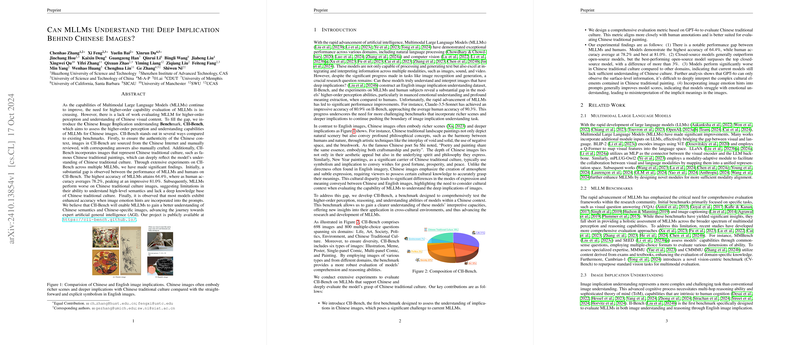Understanding MLLMs' Capabilities in Interpreting Chinese Image Implications
The paper "Can MLLMs Understand the Deep Implication Behind Chinese Images?" addresses the capacity of Multimodal LLMs (MLLMs) to comprehend intricate Chinese visual content. This paper primarily focuses on evaluating MLLMs using a novel benchmark called the Chinese Image Implication understanding Benchmark (CII-Bench). The research aims to explore and assess the higher-order perception, reasoning, and understanding of Chinese cultural contexts by these models.
CII-Bench Characteristics
CII-Bench comprises 698 images from the Chinese Internet, carefully curated to include traditional Chinese paintings and modern cultural depictions such as memes and posters. This diversity ensures a comprehensive evaluation of MLLMs across various domains, including Life, Art, Society, Politics, Environment, and Chinese Traditional Culture. Each image is paired with multiple-choice questions, testing the model's ability to deduce deeper meanings and cultural implications.
Experimental Evaluation
Experiments conducted across several MLLMs reveal notable findings:
- A discernible gap exists between human and model performance. Humans, on average, achieved 78.2% accuracy, while the best MLLM attained only 64.4%.
- MLLMs significantly struggle with images related to Chinese traditional culture, indicating a lack of intricate understanding of cultural nuances.
- Incorporating image emotion hints enhances model accuracy, suggesting difficulties in grasping emotional subtleties.
Prompt Engineering Insights
The paper explores various prompts, including Chain-of-Thought (CoT) and domain-specific prompts. CoT did not significantly benefit most models and occasionally led to performance degradation. Meanwhile, providing emotion-related cues proved beneficial, reinforcing the necessity for emotion-aware processing in MLLMs.
Evaluation of Chinese Traditional Paintings
A specialized evaluation metric assesses MLLMs' comprehension of Chinese traditional paintings, focusing on aspects such as Surface-level Information and Cultural History. GPT-4o scored 2.71 on this metric, exemplifying how current models capture surface details but not the deeper cultural connotations inherent in traditional Chinese artworks.
Error Analysis
The paper's error analysis identifies prevalent model deficiencies: neglect of key information, over-inference, and superficial reasoning. Notably, models exhibit a fundamental misalignment with Chinese cultural contexts, largely attributed to a deficit in historical and cultural knowledge.
Implications and Future Directions
This research highlights significant challenges and opportunities for improving MLLMs in cross-cultural understanding and interpretation. The introduction of CII-Bench provides a platform for developing models that better understand intricate cultural nuances and advance towards expert AGI. Future work could focus on enriching cultural databases and enhancing multimodal fusion techniques.
In summary, the paper elucidates the complexities inherent in training models to seamlessly integrate and interpret visual content rich in cultural implications. It underscores the importance of developing benchmarks like CII-Bench to push the boundaries of current AI capabilities towards a more profound, culturally nuanced understanding.
